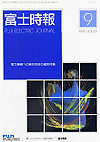FUJI ELECTRIC JOURNAL Vol.69-No.9 (Sep/1996)
 |
Analysis Technologies for Thermal Power Plant Equipment |
Recent Analysis Technologies for Thermal Power Plant Equipment
Yoshihiro Sakai, Ikuo Kishi
To achieve high reliability and efficiency required by the plant components such as steam turbines and generators, a very high level of quality control is necessary at each stage of design, manufacturing, and inspection. Three-dimensional (3D) CAD is increasingly used for design of thermal power plant components in place of 2D CAD, and 3D CAE which integrates design, analysis, manufacturing, and inspection is now developed. Because of the downsizing and upgrading of computers, simulating calculations can be carried out with workstations and personal computers, producing powerful effects on optimized design.
Application of Flow Analysis Technologies to Steam Turbine Design
Kenji Nakamura, Hideo Kato
In designing steam turbines, an accurate, precise grasp of the internal steam flow is greatly effective to improve not only the efficiency but also reliability, including the prediction of vibration. With the recent progress of fluid flow analysis, particularly of computational fluid dynamics, the precise simulation of a high-speed flow in the blade row and a viscous flow has come into practical use. Applying these data to the optimized design, Fuji Electric developed high-efficiency, new-generation low-pressure blades and 3DS reaction blades and is further extending the scope of application to the exhaust casing, etc.
Recent Analysis Technologies for Hydropower Equipment
Kentaro Akahane, Ryoji Suzuki
Nowadays for hydropower equipment, computers are used in various forms at every stage from receiving orders to installation and testing on site. This paper takes up the analyses of flows, stresses, vibration and transient phenomena frequently used at the stages of planning and designing, and reviews their history and recent technologies.
Vibration Analysis Technologies for High Head Pump-Turbine Runners
Ryoji Suzuki, Yutaka Kimoto, Masayoshi Sakata
As the head of pumped storage power plants becomes higher, the importance of technology for predicting stress fluctuations in the pump-turbine runner increases. This paper describes how the vibration characteristics of pump-turbine runneres can be grasped with enough precision at the design stage using stress fluctuation predicting technology based on fluid-structure coupled vibration analysis and stress measurement technology with actual head model test apparatus.
Application of Numerical Flow Analysis Technologies to Hydraulic Turbines and Pump-Turbines
Yi Qian
As engineering work stations and personal computers are reduced in price and increased in speed, flow analysis technology has come into use as design tools. This paper introduces application examples of an up-to-date high-accuracy, three-dimensional, numerical viscous-flow analysis technique, based on our original development, to hydraulic turbines and pump-turbines as well as the reliability and economy of the three-dimensional flow analysis technique.
Application of Computer Analysis to Engineering of Nuclear Power Plants
Hiroshi Ozaki, Keisuke Jinza, Kazuhiro Koga
Fuji Electric's nuclear power division mainly developed, designed, and manufactured fuel handling and storage facilities for reactors under development such as the prototype FBR Monju. These plants were independently developed in Japan and many analysis programs were introduced or developed as design and development tools. Analysis programs recently used are roughly classified into (1) structure and seismic analysis (2) flow dynamic analysis (3) core, shield, and criticality analyses (4) safety analysis. Recent improvement in computer performances has raised the efficiency of analyses for engineering.
Recent Analysis Technologies for Substation Equipment
Hideo Kaneko, Mutsuo Tsutsumi, Masaaki Kosaka
The development of substation equipment needs to attain required performances by satisfying many dynamic and static conditions mutually related such as mechanical strength, electric fields, heat, flows, and stresses. This paper introduces analysis technologies recently used by Fuji Electric. Used for transformers are (1) grasping electric fields with electric field analysis (2) optimizing structure shapes with three-dimensional magnetic field analysis (3) simulating the cooling of windings. For switchgear, (1) improving precision with three-dimensional electric field analysis (2) optimizing spacer shapes with stress analysis (3) predicting interrupting capacity with interrupting hot-as flow analysis.
Application of Flow Analysis Technologies to Cooling of Gas-Immersed Transformers
Yoshitake Nakagami, Shinichi Ogura, Motoo Wada
To improve the cooling performance of transformers, it is necessary to grasp the details of flows and rises in temperature particularly near the windings. This paper introduces Fuji Electric's recent flow analysis technologies and an application example to a gas-immersed transformer which as a cooling medium uses SF6 gas with a smaller heat capacity than insulation oil for oil-immersed transformers.
Interrupting Phenomena and Hot gas Flow Analysis of gas Circuit Breakers
Ken Satoh, Shuinchi Sugiyama, Masahiko Fujita
To realize miniaturization of the gas circuit breakers (GCB), the parts where voltage is applied must be prevented from reducing withstand voltage due to hot gas generated by current interruption. This paper introduces examples of measurements of withstand voltage characteristics in the GCB tank and examples of investigation to improve withstand voltage characteristics using gas flow analysis.
Recent Analysis Technologies for Rotating Machines
Kenji Endo
This paper introduces recent analysis technologies for networks, transient phenomena, electromagnetic fields, and structures, used in design and R & D, citing examples for each analysis: rapid solution to flux distribution in an air gap region by transforming into Fourier series with separated variables, modeling of a harmonics compensating synchronous machine, solution to subtransient reactance due currents induced in the massive rotor of a large permanent magnet machine and demagnetizing flux distribution in a magnet at a short circuit, and the result of vibration analysis for a main propulsion motor with permanent magnets.
Ventilation and Cooling Analysis Technologies for Electric Rotating Machines
Ryuichi Ujiie, Tsutomu Yamamoto
The equivalent network method is widely used to predict the ventilation and cooling performances in electric rotating machines. With the recent rapid progress of computer technology, simulations of cooling air flows in these machines are made possible by flow analysis. The introduction of flow analysis greatly improves the precision of prediction for cooling performances as well as contributes to efficient development of new air circulation systems. This paper mainly describes the simulation technology for cooling air flows in rotating machines using flow analysis, citing some application examples.

